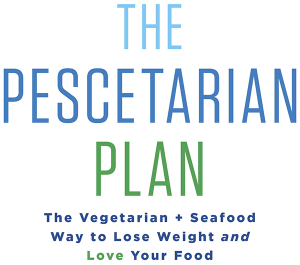
Before I go into the ins and outs of buying a multi vitamin/mineral tablet, first you should decide if you even need one. If you’re on The Pescetarian Plan you’re getting such a super-nutritious diet, you might not need this supplement. To help you decide, check out Do You Need a Multi?
When it comes to multis, less is more. While some nutrients seem to be harmless in amounts ten times the RDA or higher, other nutrients are risky at these levels. For instance, too much selenium has been linked to an increased risk of type 2 diabetes and possibly some types of cancer. Some—but not all—studies link excess folic acid to an increased risk for colon cancer. So bring your reading glasses to the vitamin aisle!
What to take
Here’s what to look for:
- 1. A serving size of 1. If you need to take more than one tablet per day, not only are you probably paying too much, but the pill’s probably loaded with unnecessary, unproven fluff.
- 2. Nutrients at 100% DV or less. Scan the “% DV” (Daily Value) column, and if many of the nutrients are over this level, put the jar back on the shelf. These are the vitamins and minerals to look out for in particular:
- Vitamin A: 20 to 60 percent of the DV (1,000 IU to 3,000 IU)—no more. About half of it should come from beta-carotene.
- Folic acid: No more than 100 percent (400 mcg). If you’re a man or a post-menopausal woman, 50 percent the DV is probably best, as there’s some research linking too much folic acid to an increased risk for colon cancer. (The studies are mixed, so it’s still not clear what’s too much.) Women of childbearing age, however, need the full 100 percent to help prevent certain birth defects.
- Iron: 100 percent the DV (18 mg) if you’re a pre-menopausal woman to replenish iron lost during your monthly period. Otherwise, 44 percent (8 mg) or less is appropriate, as too much iron is linked with heart disease. However, if you tend to be iron deficient, then, of course, consult with your healthcare provider about supplementing with this mineral.
- Selenium: No more than 100 percent the DV. Some—but not all—studies suggest that giving men 200 mcg daily, which is 2.8 times the DV, showed an increase in type 2 diabetes risk.
The following are OK in above-RDA levels:
- Vitamin C: From 100 to 333 percent (200 mg) is an appropriate range.
- Vitamin D: If you’re not taking a separate vitamin D supplement, and you’re age 50 or younger, then make sure your multi contains 150 to 250 percent the DV (600 to 1,000 IU). From age 50 and up, the multi should have 250 percent (1,000 IU).
- Vitamin E: From 100 to 150 (30 to 45 IU) is appropriate.
- Vitamin B12: If you’re age 51 or older, your multi should have 417 percent (25 mcg) to 833 percent (50 mcg) to combat any possible age-related problems with absorbing this vitamin. If you’re age 50 or younger, 100 percent, or 6 mcg, is adequate.
- Thiamin and riboflavin. Most multis throw in above-RDA amounts, which you probably don’t need, but are generally safe. In fact, there’s no upper limit of safety set for these vitamins. That doesn’t mean there isn’t a level at which they’re unsafe, but the research hasn’t yet figured it out. Still, there’s no need to take more than 100 percent the DV.
- 3. Skip the extras. There’s no need to take guarana, caffeine, and other herbs—in fact, these things can be dangerous. Other extras, like broccoli powder or phytonutrients, aren’t harmful, but there’s no way to tell if they’re helpful. Besides, these substances tend to bloat pills, making it necessary to take two pills instead of one just to get the basics.
Buying pointers: You want your multi to contain the levels of nutrients stated on the label and to dissolve properly so you actually absorb the nutrients. Consumer Labs, which tests multis and other supplements, found that in a 2013 test of 42 leading brands, two dissolved too slowly, another 13 had lower levels of certain nutrients stated and one had higher levels. So, it’s a bit of an uncertain venture choosing a multi.
In general, it’s best to go with well-established major brands, like Walmart, CVS, and Rite-aid (they generally come out fine in these tests). I wish I could better guide you to specific brands, but without comprehensive testing, we just don’t know what’s best.






